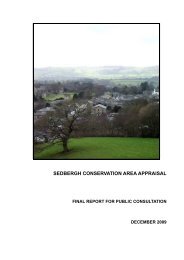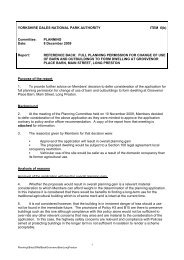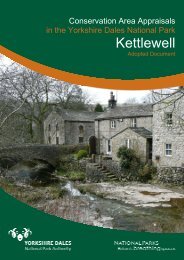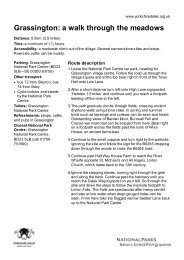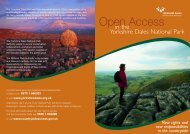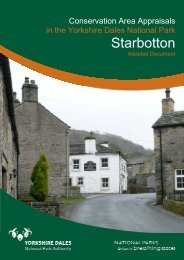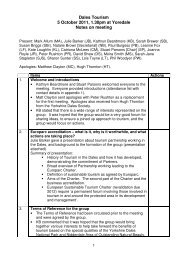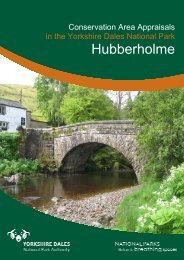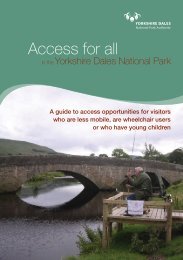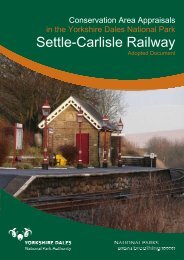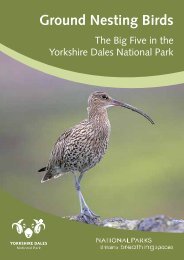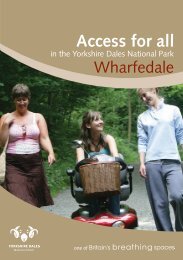Figure 36: Sundial and relief,Old Vicarage (photo © GabyRose, YNDPA, 2009)16DCLG et al. (2010) PPS5:Historic EnvironmentPlanning Practice Guide,paragraph 124.f) Prevalent Local and Traditional Building Materials and the PublicRealmTraditional materials, surfaces and street furniture can contributepositively to the significance of a conservation area as they have thepotential of providing a unique setting to the historic architecture, giventhey are well kept and in good condition. Likewise, inappropriatematerials, surfaces and street furniture will have a detrimental effect tosome extent and, in extreme cases, even put the whole conservationarea at risk. In addition, [t]ransport proposals can affect the setting ofheritage assets and highways authorities are advised to consult with thelocal planning authority in such circumstances 16 .Traditional materials. The vernacular buildings of the <strong>Langcliffe</strong>Conservation Area are mainly made of local limestone, though somefacades have external renders in muted colours. Chimneys, and windowand door surrounds are also in stone, and roofs covered in slate tiles laidin diminishing courses. There are only few painted features, such assome window surrounds, which are kept in neutral tones of white orcream. The overall appearance of the built environment is that of naturalshades of grey and rough textured surfaces.Timber is used for authentic windows and doors, cast iron for rainwatergoods, and clay pots for chimneys. Unfortunately, some of these featureshave been replaced with uPVC items, which have a detrimental effect onappearance of the buildings (see 4.4.k).Public realm. While most of the roads and lanes are covered in tarmacfor vehicular use, the area surrounding the fountain has a reinstatedcobbled surface (figure 20). Overall, the hard standing is very wellbalanced with the grassed areas in the village. There is a mixture ofmodern concrete and cobbled kerbs, as well as individual stones alongverges to keep people from driving onto the grass, and some very goodexamples of gullies and edge-of-carriage cobbles and stonework.It is unusual that the village entrance to the north is sometimes gated.The gate, however, is rusty metal and not of a local <strong>Dales</strong> style. Streetfurniture includes several late-twentieth-century lamp posts, which arequite inappropriate for <strong>Langcliffe</strong> Conservation Area. Wooden waymarkers and telegraph poles recede well into the background. Forrecreational purposes, several timber benches are dotted around theGreen, along with a basic children’s playground on its southern edge.There is a circular bench around the Stocks Tree with high metal fencingbehind which detracts from the tree. At the Green’s northern tip, there is anotice board with written codes of behaviour. Conservation works to thiswere grant aided by the Authority in 1993/4. Finally, the traditional castironroad names work well with the historic environment.34
g) Contribution Made to the Character of the Area by Green Spacesand Its Biodiversity ValueGreen spaces. The contribution made by the large green space in thecentre of <strong>Langcliffe</strong> is essential to the special interest of the entireconservation area. Its experience of space, views and interrelationshipwith the built environment defines much of the appearance of the village.Smaller public grassed areas and private gardens also add to thecharacter, although their impact is fairly subtle. In contrast, the grounds ofthe <strong>Langcliffe</strong> Hall are not in public view but can be seen from the hills.Trees. The trees in <strong>Langcliffe</strong> are predominantly deciduous. Within thebuilt-up area of the village they are limited to small ornamental, fruit andnative trees. Some larger gardens have conifers, but on the wholeMountain ash/rowan can be found. Many of the lanes and yards on theextremities of the village have mature elder on verges and unusedland. Although not technically trees, they do add character, greenery and‘naturalness’. Lack of space has prevented growth of any significantlysized tree in the built-up area.Thus the main trees are found on the Green, and within the grounds ofSt. Johns Church, <strong>Langcliffe</strong> Hall and Bowerley.Opposite St John the Evangelist, a V-shaped row of trees lines the grassverges and effectively closes off the top end of the Green, with the mostdominant trees running along the lane opposite the church (figure 19).These are at least sixty years old and will easily last for another sixtyyears. Other trees on the Green include horse chestnut, birch, cherry,rowan, hawthorn, beech and alder. They are all in reasonable conditionand should have another eighty to one hundred years, although thecherry and birch will not last for much more than thirty to forty years dueto their younger age of maturity. The horse chestnuts are exhibiting signsof bleeding canker which may reduce their vigor and structuralcondition. They are, however, not a significant species locally, so amenitywill not be much affected should they be removed in the future. Finally,there is scope for some pruning and maintenance to the trees on theGreen.On the nearby central square the Stocks Tree (figures 20 & 21), asycamore, is a replacement for one that was felled in 1996 due to its poorcondition. This one, too, is in ill health and struggling with the site. TheAuthority’s Tree Officer does not anticipate it recovering to full health andis in contact with the Parish Council as to how best to deal with it.A substantial group of trees at St. John’s forms an impressive backdropto the Green, hiding the church, and extending beyond the conservationarea onto the hills behind (figure 17). The west of the graveyard hasmature sycamore, ash and yew which contribute well to the amenity, aswell as some holly and oak. These trees are mature, in reasonable healthand good structural form, and will last for at least the next thirty years.The large trees along the <strong>Langcliffe</strong> Hall boundary wall rather act as anadditional barrier to the main road than a means of framing the property.Tree Preservation Order No. 3 (Settle) 1965 A1 protects much of thegardens and farmland south of the Hall. When viewed from the highway,the dominant trees appear to be mature beech. Boundary trees of yew,sycamore and lime also are present, with younger planting dottedabout. The mature beech appears to have been planted at around thesame time, so they may all decline together at some point in the future.At Bowerley there are similar tree species as elsewhere like ash, beech,sycamore, and the odd Scots pine. When viewed from the highway theyappear to be in good health and are likely to provide amenity for manyyears. These are currently protected from felling by the conservation area35



